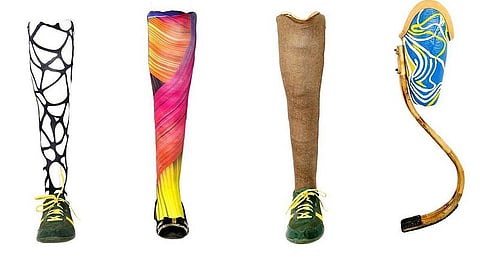
- HOMEGROWN WORLD
- #HGCREATORS
- #HGEXPLORE
- #HGVOICES
- #HGSHOP
- CAREERS
- ABOUT US
- CONTACT US

Turns out that the next big breakthrough in affordable prosthetics has been sitting right under our nose the entire time, or in Arun Cherian’s case, he was sitting on it the entire time. Yes, your Grandma’s cane furniture has a place not only in the past, but in the future as well.
Cherian was on a brief sojourn in his family’s home in Kerala when he had his eureka moment for the development of prosthetics. An engineer at Purdue at the time, he was left perturbed by the costs of modern prosthetics while working on bio-inspired designs for the differently abled. Evidently, his little grey cells were continuing to contemplate a method to make high-functioning prosthetics that were financially accessible for all people.
It was then that the apple fell—Cherian looked at the copious amount of cane furniture around his family home and started mentally tabulating the materials’ properties. Cane is malleable, cheap, and durable—everything one needs in a functioning prosthetic leg. Speaking to the International Development Innovation Network, Cherian states, “in Kerala, we have cane furniture bent in all of these beautiful ways and it takes a lot of weight. It’s basically a spring. Biomechanically, our leg is also a spring of tuned stiffness...And I wondered if you could make a prosthetic leg of tuned stiffness out of cane”. Cherian pursued the idea by visiting a local cane artisan, and it resulted in a design that was so ingenious it even caught MIT’s eye.
Through his tapered design Cherian managed to leverage cane’s inherent flexibility without limiting its ability to support large amounts of weight. Moreover, according to MIT’s D-LAB, Rise Legs, what he named his creation, are up to four times lighter than similarly priced products. Cherian’s sturdy and light prototype further convinced him that he could equip the differently abled community with a useful tool, leading him to test his design at Bangalore’s Department of Aerospace at the Indian Institute of Science, as well as complete clinical trials at St. John’s Hospital.
During Cherian’s initial clinical trials he immediately changed the lives of three participants who were not only able to regain better bipedal function, but could once again pursue their sporting inclinations. During Cherian’s first trial Madu, a young boy who lost both legs in a railway accident, was able to kick a football shortly after trying out his new legs and has now returned to his passion of running. Parveen, a dancer who lost her legs was also able to return to her athletic calling and is now enrolled in Chrysallis Dance School in Bangalore. But perhaps the candidate that turned the most heads was bodybuilder Prajwal Ranjith, who commented to The Economic Times, “with the help of Rise legs I was able to finish the 6 km TCS marathon nonstop without any bruises.”
Cherian concedes that despite the visible success of his breakthrough many people are still skeptical of the strength of the cane-based leg. Even though Cherian’s testing has lead him to believe his creation can hold up to three times the average adult body weight, he finds the best way to appease people’s reservations is to ask them to try and break the prosthetic device. “I give them the equipment and ask them to try and break it. Whatever they do, it just does not break. This experience gives them the confidence” he explained to The Better India.
In addition to opening the gateway to affordable and high-functioning prosthetics in India, Cherian is now working with a team of students, belonging to MIT D-Lab’s Design for Scale class, in an effort to produce Rise Legs at a larger scale for the global market. Also, two competitors in the world’s first Cybathlon, Olympics for bionic athletics, were sponsored by Rise Legs. The participants Nagesh Chowdappa and Prajwal Basavaraja traveled to Switzerland and placed seventh and eighth, respectively, in the Powered Leg Prothesis Race. Even though traditional bionic methods are still taking the lead, it is important to note that Rise Legs competed against bionic technology that costs tens of thousands of dollars, as opposed to ten thousand rupees. Perhaps as Cherian continues to perfect Rise Legs, there will come a day when we will see cane-aided atheletes leading the races to come.
